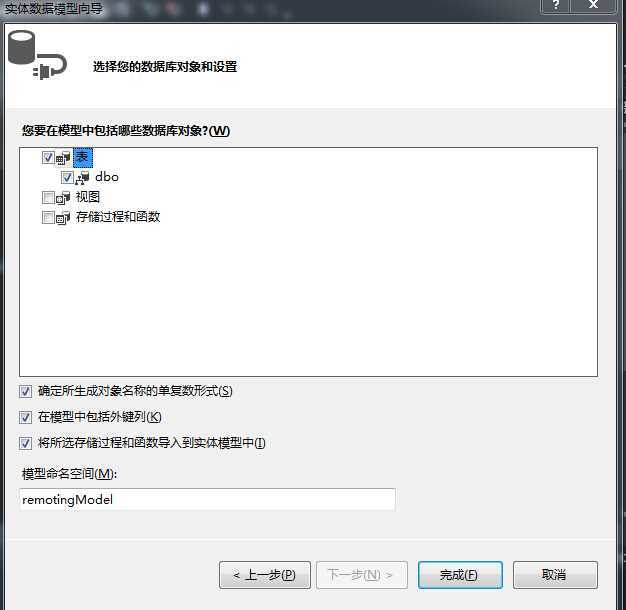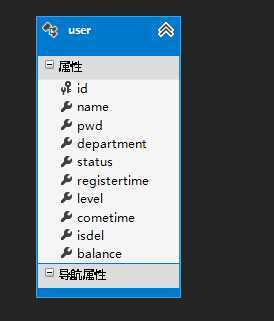标签:des style class blog code http
文章是作为初学者记录之用,没有学习过的同学可以借鉴一下,至于用过和高手嘛,就算了吧。仅是入门。废话不多说了,马上新建个项目,添加Entity Framework,这个词以下将用EF代替。
本文使用的IDE为vs2012。我是新建了一个控制台项目,然后添加的EF,以后我会使用EF作为类库添加到项目中,但这次仅作了解。

选择Ado.net实体数据模型,文件名随便,我在这里选择了默认名称Model1.edmx,

在弹出的对话框中选择从数据库生成,这里有个名称叫做dbfirst,就是说数据库先存在,然后根据数据库生成实体模型等。

选择新建连接,然后选择你要实现的数据库和表,

表可以选择数据库中的一部分,也可以选择全部,这要看你的需要了,这里只做学习用,所以我只选择了一个user表。点击完成,这过程可能要等一会,因为要导入很多dll。
之后我们会看到一个类似

uml图,这要归结为vs的强大了,其实edmx文件就是一个xml文档,你可以使用xml打开方式打开这个edmx文件。下面是我的edmx文件
1 <?xml version="1.0" encoding="utf-8"?> 2 <edmx:Edmx Version="3.0" xmlns:edmx="http://schemas.microsoft.com/ado/2009/11/edmx"> 3 <!-- EF Runtime content --> 4 <edmx:Runtime>
5 <!-- SSDL content --> 6 <edmx:StorageModels> 7 <Schema Namespace="remotingModel.Store" Alias="Self" Provider="System.Data.SqlClient" ProviderManifestToken="2008" xmlns:store="http://schemas.microsoft.com/ado/2007/12/edm/EntityStoreSchemaGenerator" xmlns="http://schemas.microsoft.com/ado/2009/11/edm/ssdl"> 8 <EntityContainer Name="remotingModelStoreContainer"> 9 <EntitySet Name="user" EntityType="remotingModel.Store.user" store:Type="Tables" Schema="dbo" /> 10 </EntityContainer> 11 <EntityType Name="user"> 12 <Key> 13 <PropertyRef Name="id" /> 14 </Key> 15 <Property Name="id" Type="nvarchar" Nullable="false" MaxLength="32" /> 16 <Property Name="name" Type="nvarchar(max)" /> 17 <Property Name="pwd" Type="nvarchar(max)" /> 18 <Property Name="department" Type="int" /> 19 <Property Name="status" Type="int" /> 20 <Property Name="registertime" Type="datetime" /> 21 <Property Name="level" Type="nvarchar" MaxLength="50" /> 22 <Property Name="cometime" Type="datetime" /> 23 <Property Name="isdel" Type="int" /> 24 <Property Name="balance" Type="money" /> 25 </EntityType> 26 </Schema> 27 </edmx:StorageModels>
28 <!-- CSDL content --> 29 <edmx:ConceptualModels> 30 <Schema Namespace="remotingModel" Alias="Self" p1:UseStrongSpatialTypes="false" xmlns:annotation="http://schemas.microsoft.com/ado/2009/02/edm/annotation" xmlns:p1="http://schemas.microsoft.com/ado/2009/02/edm/annotation" xmlns="http://schemas.microsoft.com/ado/2009/11/edm"> 31 <EntityContainer Name="remotingEntities" p1:LazyLoadingEnabled="true"> 32 <EntitySet Name="users" EntityType="remotingModel.user" /> 33 </EntityContainer> 34 <EntityType Name="user"> 35 <Key> 36 <PropertyRef Name="id" /> 37 </Key> 38 <Property Name="id" Type="String" Nullable="false" MaxLength="32" Unicode="true" FixedLength="false" /> 39 <Property Name="name" Type="String" MaxLength="Max" Unicode="true" FixedLength="false" /> 40 <Property Name="pwd" Type="String" MaxLength="Max" Unicode="true" FixedLength="false" /> 41 <Property Name="department" Type="Int32" /> 42 <Property Name="status" Type="Int32" /> 43 <Property Name="registertime" Type="DateTime" Precision="3" /> 44 <Property Name="level" Type="String" MaxLength="50" Unicode="true" FixedLength="false" /> 45 <Property Name="cometime" Type="DateTime" Precision="3" /> 46 <Property Name="isdel" Type="Int32" /> 47 <Property Name="balance" Type="Decimal" Precision="19" Scale="4" /> 48 </EntityType> 49 </Schema> 50 </edmx:ConceptualModels>
51 <!-- C-S mapping content --> 52 <edmx:Mappings> 53 <Mapping Space="C-S" xmlns="http://schemas.microsoft.com/ado/2009/11/mapping/cs"> 54 <EntityContainerMapping StorageEntityContainer="remotingModelStoreContainer" CdmEntityContainer="remotingEntities"> 55 <EntitySetMapping Name="users"> 56 <EntityTypeMapping TypeName="remotingModel.user"> 57 <MappingFragment StoreEntitySet="user"> 58 <ScalarProperty Name="id" ColumnName="id" /> 59 <ScalarProperty Name="name" ColumnName="name" /> 60 <ScalarProperty Name="pwd" ColumnName="pwd" /> 61 <ScalarProperty Name="department" ColumnName="department" /> 62 <ScalarProperty Name="status" ColumnName="status" /> 63 <ScalarProperty Name="registertime" ColumnName="registertime" /> 64 <ScalarProperty Name="level" ColumnName="level" /> 65 <ScalarProperty Name="cometime" ColumnName="cometime" /> 66 <ScalarProperty Name="isdel" ColumnName="isdel" /> 67 <ScalarProperty Name="balance" ColumnName="balance" /> 68 </MappingFragment> 69 </EntityTypeMapping> 70 </EntitySetMapping> 71 </EntityContainerMapping> 72 </Mapping> 73 </edmx:Mappings>
74 </edmx:Runtime> 75 <!-- EF Designer content (DO NOT EDIT MANUALLY BELOW HERE) --> 76 <Designer xmlns="http://schemas.microsoft.com/ado/2009/11/edmx"> 77 <Connection> 78 <DesignerInfoPropertySet> 79 <DesignerProperty Name="MetadataArtifactProcessing" Value="EmbedInOutputAssembly" /> 80 </DesignerInfoPropertySet> 81 </Connection> 82 <Options> 83 <DesignerInfoPropertySet> 84 <DesignerProperty Name="ValidateOnBuild" Value="true" /> 85 <DesignerProperty Name="EnablePluralization" Value="False" /> 86 <DesignerProperty Name="IncludeForeignKeysInModel" Value="True" /> 87 <DesignerProperty Name="CodeGenerationStrategy" Value="无" /> 88 </DesignerInfoPropertySet> 89 </Options> 90 <!-- Diagram content (shape and connector positions) --> 91 <Diagrams></Diagrams> 92 </Designer> 93 </edmx:Edmx>
上面我用空行隔出来了三个部分,第一部分就是描述数据库,包括字段,字段类型。第二部分就是实体模型,注意下面的t4模板要用到这个部分。最后部分就是映射文件,也就是将第一部分与第二部分的内容之间的桥。对应关系。
下面我们打开Model1.tt文件,这里如果我们直接打开,效果就是一个txt文本。我们可以安装一个插件,在工具中选择扩展和更新,联机中搜索t4 editor,下载安装,重启vs,重新打开Model1.tt文件就可以看到效果了,这个文件读取之前的edmx文件,遍历edmx实体及实体的属性,生成相应实体的cs文件。我们可以说Model1.tt文件主要的作用就是生成实体文件的。还有一个context.tt文件,从文件名我们可以猜个大概(上下文,我们常常用这个东西操作好多东西),这时我们可以想一下,EF是用来操作数据库的,现在数据实体有了,怎么进行增删改查呢?对,就是这个context。我们这就来看看这个context.cs文件吧,

1 namespace EFConsole 2 { 3 using System; 4 using System.Data.Entity; 5 using System.Data.Entity.Infrastructure; 6 7 public partial class remotingEntities : DbContext 8 { 9 public remotingEntities() 10 : base("name=remotingEntities") 11 { 12 } 13 14 protected override void OnModelCreating(DbModelBuilder modelBuilder) 15 { 16 throw new UnintentionalCodeFirstException(); 17 } 18 19 public DbSet<user> users { get; set; } 20 } 21 }
似乎文件内容好少啊,别急,看父类DBContext,父类的方法很多。
remotingEntities类会将所有的数据实体封装成一个集合,然后让我们操作实体。
下面让我们来看看这个上下文的强大功能吧
简单的增删改查功能

1 using System; 2 using System.Collections.Generic; 3 using System.Linq; 4 using System.Text; 5 using System.Threading.Tasks; 6 7 namespace EFConsole 8 { 9 class Program 10 { 11 public static remotingEntities dbContext = new remotingEntities(); 12 static void Main(string[] args) 13 { 14 15 add(); 16 select(); 17 update(); 18 remove(); 19 Console.ReadKey(); 20 } 21 22 23 #region 添加方法 24 /// <summary> 25 /// 添加方法 26 /// </summary> 27 public static void add() 28 { 29 int res = -1; 30 user tempData = new user() { name = "test", id = "1", balance = 1 }; 31 dbContext.users.Add(tempData); 32 res = dbContext.SaveChanges(); 33 if (res > 0) 34 { 35 Console.WriteLine("add function:suc"); 36 } 37 else 38 { 39 Console.WriteLine("add function:fail"); 40 } 41 } 42 #endregion 43 44 #region 查询方法 45 /// <summary> 46 /// 查询方法 47 /// </summary> 48 public static void select() 49 { 50 user tempData = dbContext.users.Where(e => e.id == "1").FirstOrDefault(); 51 Console.WriteLine("select function:" + tempData.name); 52 } 53 #endregion 54 55 #region 修改方法 56 /// <summary> 57 /// 修改方法 58 /// </summary> 59 public static void update() 60 { 61 int res = -1; 62 user tempData = dbContext.users.Where(e => e.id == "1").FirstOrDefault(); 63 Console.WriteLine("before update function:" + tempData.name); 64 tempData.name = "update name"; 65 res = dbContext.SaveChanges(); 66 if (res > 0) 67 { 68 Console.WriteLine("update function:suc,update data userName is" + tempData.name); 69 } 70 else 71 { 72 Console.WriteLine("update function :fail"); 73 } 74 } 75 #endregion 76 77 #region 删除方法 78 /// <summary> 79 /// 删除方法 80 /// </summary> 81 public static void remove() 82 { 83 int res = -1; 84 user tempData = dbContext.users.Where(e => e.id == "1").FirstOrDefault(); 85 dbContext.users.Attach(tempData); 86 dbContext.users.Remove(tempData); 87 res = dbContext.SaveChanges(); 88 if (res > 0) 89 { 90 Console.WriteLine("remove function :suc"); 91 } 92 else 93 { 94 Console.WriteLine("remove function :fail"); 95 } 96 } 97 #endregion 98 } 99 }

成功了哦,不信可以去数据库证实一下。
今天就写到这里了,有时间还会将EF当做类库写一个简单的测试。
EntityFramework 学习第一天,布布扣,bubuko.com
标签:des style class blog code http
原文地址:http://www.cnblogs.com/ljs0322/p/3787664.html